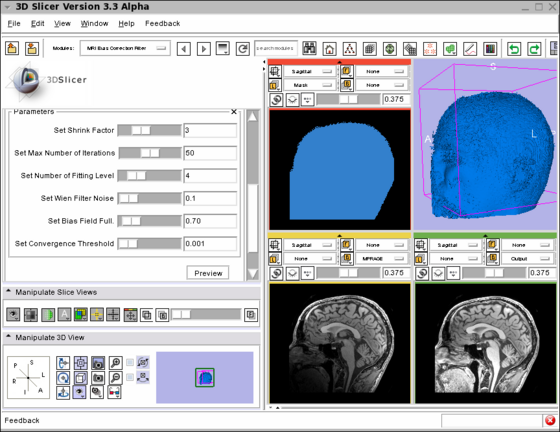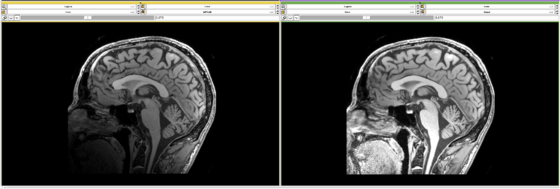Difference between revisions of "Modules:MRIBiasFieldCorrection-Documentation-3.5"
Sylvainjaume (talk | contribs) |
|||
| (9 intermediate revisions by one other user not shown) | |||
| Line 8: | Line 8: | ||
{| | {| | ||
| − | |[[Image: | + | |[[Image:MRI_Bias_Field_Correction_Slicer3.png|thumb|560px|Screenshot of the MRIBiasFieldCorrection module in Slicer3 during development. |
| − | + | The screenshot illustrates the application of the MRI Bias Field Correction on the SPL Atlas. | |
| + | Note that the interface was simplified for the production version. | ||
| + | The top left window shows the mask used to defined the ROI where the correction will be applied. | ||
| + | The top right window shows the rendering of the 3D model created using the mask. | ||
| + | The bottom left window shows one slice in the input image. | ||
| + | Note the intensity inhomogeneity from the bottom left corner (dark) to the top right corner (bright). | ||
| + | The bottom right window shows the output image after the application of the MRI Bias Field Correction module. | ||
| + | The parameters used for the correction are shown on the left panel of the Slicer3 interface.]] | ||
|} | |} | ||
| + | |||
| + | {| | ||
| + | |[[Image:MRI_Bias_Field_Correction_Slicer3_close_up.png|thumb|560px|Close-up of the above screenshot showing the image before and after correction. | ||
| + | Note that the intensity inhomogeneity visible in the input image (left) has been corrected in the output image (right).]] | ||
| + | |} | ||
| + | |||
| + | This module enables the user to get a fast preview of the Bias Field Correction applied on a 2D slice. | ||
| + | The advantage of this preview is to try different parameters and visualize the effect in real time. | ||
| + | |||
| + | A Command Line version of this module has been developed to enable the Slicer3 Testing framework. | ||
| + | Hence this module is tested during every Nightly build and the result is reported in the Slicer3 Dashboard. | ||
== General Information == | == General Information == | ||
| Line 22: | Line 40: | ||
* Nicolas Rannou: Harvard Medical School, Brigham and Women's Hospital | * Nicolas Rannou: Harvard Medical School, Brigham and Women's Hospital | ||
* Sylvain Jaume: MIT Computer Science and Artificial Intelligence Laboratory | * Sylvain Jaume: MIT Computer Science and Artificial Intelligence Laboratory | ||
| − | * Contact: | + | * Contact: <nrannou at bwh.harvard.edu>, <sylvain at csail.mit.edu> |
===Module Description=== | ===Module Description=== | ||
| Line 28: | Line 46: | ||
== Usage == | == Usage == | ||
| − | * Load the input dataset (Add Volume) | + | * Load the input dataset (Main menu: Add Volume) |
| − | * | + | * Create a Mask Volume using the Editor (Modules > Editor) (the Threshold tool should give a good result) |
| − | * Select the | + | * Select the MRIBiasFieldCorrection module (Modules > Filtering > MRIBiasFieldCorrection) |
| − | * | + | * In the left panel, select the Input Volume |
| − | * Modify the | + | * Select the Mask Volume |
| − | * Click on Apply | + | * In the Preview Volume menu , select 'Create New Volume' |
| − | * Select the ' | + | * Do the same for the Output Volume menu |
| + | * Modify the parameter values if desired (default values gave good results during our experiments) | ||
| + | * Click on Apply. | ||
| + | |||
| + | It took 32 min to process a 512x512x30 MRI volume on a MacBook laptop. | ||
| + | To visualize the result: | ||
| + | * Deselect the Overlay volume, | ||
| + | * Select the input as Background volume and the output as Foreground volume. | ||
| + | * Go to Modules > Volumes | ||
| + | * Select the input volume, and write down the values for Window and Level | ||
| + | * Select the output volume, and apply the same values | ||
| + | * Move the lower left cursor in 'Manipulate Slice Views' between B (background) and F (foreground) | ||
===Examples, Use Cases & Tutorials=== | ===Examples, Use Cases & Tutorials=== | ||
| Line 54: | Line 83: | ||
===Dependencies=== | ===Dependencies=== | ||
| − | + | No other modules or packages are required to use this module. | |
| + | |||
===Known bugs=== | ===Known bugs=== | ||
| Line 64: | Line 94: | ||
Follow this [http://na-mic.org/Mantis/main_page.php link] to the Slicer3 bug tracker. Please select the '''usability issue category''' when browsing or contributing. | Follow this [http://na-mic.org/Mantis/main_page.php link] to the Slicer3 bug tracker. Please select the '''usability issue category''' when browsing or contributing. | ||
| + | |||
===Source code & documentation=== | ===Source code & documentation=== | ||
| − | * [http://viewvc.slicer.org/viewcvs.cgi/trunk/ | + | * [http://viewvc.slicer.org/viewcvs.cgi/trunk/Modules/MRIBiasFieldCorrection/ Source code] |
| − | * [http://www.na-mic.org/Slicer/Documentation/Slicer3/html/ Documentation generated by Doxygen] | + | * [http://www.na-mic.org/Slicer/Documentation/Slicer3-doc/html/ Documentation generated by Doxygen] |
== More Information == | == More Information == | ||
Latest revision as of 23:04, 15 January 2010
Home < Modules:MRIBiasFieldCorrection-Documentation-3.5Return to Slicer 3.5 Documentation
MRI Bias Field Correction
Filtering:MRIBiasFieldCorrection
This module enables the user to get a fast preview of the Bias Field Correction applied on a 2D slice. The advantage of this preview is to try different parameters and visualize the effect in real time.
A Command Line version of this module has been developed to enable the Slicer3 Testing framework. Hence this module is tested during every Nightly build and the result is reported in the Slicer3 Dashboard.
General Information
Module Type & Category
Type: Interactive or CLI
Category: Filtering
Authors, Collaborators & Contact
- Nicolas Rannou: Harvard Medical School, Brigham and Women's Hospital
- Sylvain Jaume: MIT Computer Science and Artificial Intelligence Laboratory
- Contact: <nrannou at bwh.harvard.edu>, <sylvain at csail.mit.edu>
Module Description
The module filters the image to remove the intensity inhomogeneity due to the MRI image acquisition.
Usage
- Load the input dataset (Main menu: Add Volume)
- Create a Mask Volume using the Editor (Modules > Editor) (the Threshold tool should give a good result)
- Select the MRIBiasFieldCorrection module (Modules > Filtering > MRIBiasFieldCorrection)
- In the left panel, select the Input Volume
- Select the Mask Volume
- In the Preview Volume menu , select 'Create New Volume'
- Do the same for the Output Volume menu
- Modify the parameter values if desired (default values gave good results during our experiments)
- Click on Apply.
It took 32 min to process a 512x512x30 MRI volume on a MacBook laptop. To visualize the result:
- Deselect the Overlay volume,
- Select the input as Background volume and the output as Foreground volume.
- Go to Modules > Volumes
- Select the input volume, and write down the values for Window and Level
- Select the output volume, and apply the same values
- Move the lower left cursor in 'Manipulate Slice Views' between B (background) and F (foreground)
Examples, Use Cases & Tutorials
- Note use cases for which this module is especially appropriate, and/or link to examples. (to be defined)
- Link to examples of the module's use (to be defined)
- Link to any existing tutorials (to be defined)
Quick Tour of Features and Use
List all the panels in your interface, their features, what they mean, and how to use them. For instance:
- Input panel:
- Parameters panel:
- Output panel:
- Viewing panel:
Development
Dependencies
No other modules or packages are required to use this module.
Known bugs
Follow this link to the Slicer3 bug tracker.
Usability issues
Follow this link to the Slicer3 bug tracker. Please select the usability issue category when browsing or contributing.
Source code & documentation
More Information
Acknowledgment
This work has been supported by NA-MIC Algorithms.
References
- A Nonparametric Method for Automatic Correction of Intensity Nonuniformity in MRI Data, J.G. Sled, A.P. Zijdenbos, and A.C. Evans, IEEE Transactions on Medical Imaging, 17(1):87–97, Feb 1998.
- Parametric Estimate of Intensity Inhomogeneities Applied to MRI, M. Styner, C. Brechbhler, G. Szekely, and G. Gerig, IEEE Transactions on Medical Imaging, 19(3):153–165, Mar 2000.
- N4ITK: Nick's N3 ITK Implementation For MRI Bias Field Correction, Tustison N., Gee J., Insight Journal, 2009.

